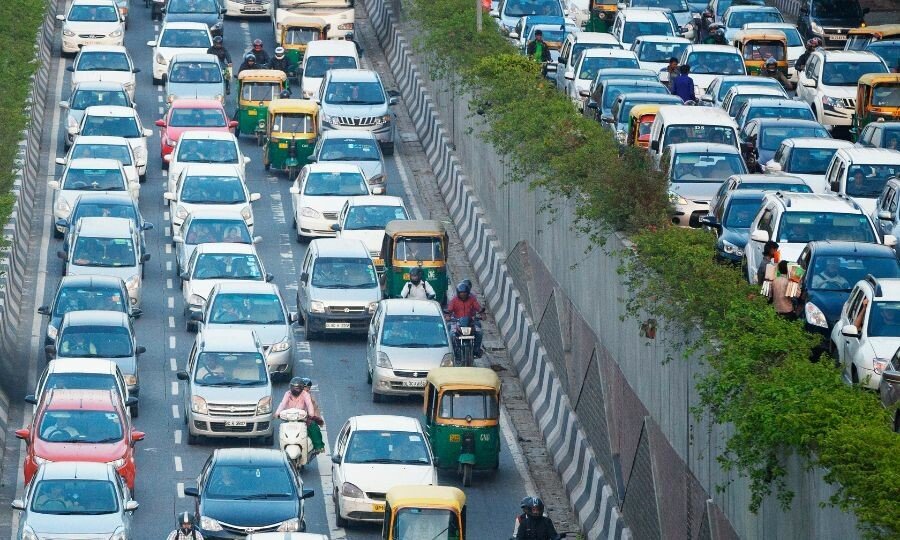Bengaluru, Mumbai, Delhi Among Cities with Worst Traffic Congestion Globally
Road Traffic Affects Quality of Life and Economic Lives of Citizens
January 13, 2025
Three Indian cities—Bengaluru, Mumbai and Delhi—rank among the slowest globally in terms of average travel speeds, according to the TomTom Traffic Index 2025. The report, drawing from over 450 billion miles driven worldwide in 2024, shows a pressing challenge for the country’s urban hubs: the deteriorating quality of urban mobility.
In Bengaluru, commuters lose an astonishing 129 hours annually during peak hours. Mumbai follows closely, with 121 hours of lost time per year, while Delhi records 128 hours, and Kolkata sees 106 hours lost annually, according to the report.
These figures translate into significant daily disruptions for ordinary citizens. The average speed in Bengaluru is just 17.4 km/h, meaning a 9.66 km journey takes over 33 minutes. In Mumbai and Delhi, average speeds of 17.5 km/h and 17.7 km/h, respectively, offer little improvement, while Kolkata’s speed is similarly sluggish at 18.2 km/h.
For ordinary residents, this translates into hours spent idling in vehicles, grappling with the frustration of missed appointments, late arrivals and reduced quality of life. Families are especially impacted as parents struggle to balance work and personal responsibilities, often sacrificing social and leisure activities due to the unpredictability of commutes.
Parents also struggle to manage school drop-offs, work commutes and household errands within a time frame that leaves little room for rest or recreation. Social activities and leisure often become secondary considerations, sacrificed to the demands of navigating clogged streets.
Further, as traffic congestion increases, so does frustration, which may lead to road rage.
The economic repercussions are equally profound.
For businesses reliant on logistics and supply chains, time is money. Delayed deliveries, increased fuel consumption and disrupted schedules inflate operational costs. Small and medium enterprises, the backbone of India’s economy, bear the brunt of this inefficiency. A restaurant unable to deliver food on time or a retailer waiting for inventory loses more than revenue—it risks its reputation.
E-commerce and last-mile delivery services, booming industries in urban India, also grapple with the challenges of unpredictable travel times. The additional costs incurred due to congestion are often passed on to consumers, creating a ripple effect that impacts overall affordability.
Furthermore, prolonged exposure to vehicular emissions in congested areas increases the risk of respiratory problems. Studies have linked traffic-related air pollution to higher incidences of asthma and other health issues.
There are several reasons for the sluggish traffic, including narrow streets, outdated road infrastructure, poorly synchronised traffic lights, peak-hour surges and unplanned construction projects. A burgeoning urban population, coupled with the rise of private vehicle ownership, has outpaced the growth of public transportation networks.
The TomTom report also mentions that outdated infrastructure and inefficient urban planning fail to accommodate modern demands. Cities like Bengaluru, once known for their green spaces and liveability, now symbolise the perils of unchecked urban expansion.
These cities must invest in robust public transportation systems. Metro projects, bus rapid transit systems and suburban rail networks must be prioritised and expanded to provide viable alternatives to private vehicles. Bengaluru’s Namma Metro, while a step in the right direction, needs faster expansion to effectively serve its growing population.
Secondly, integrating technology into traffic management can yield significant improvements. Real-time traffic monitoring, AI-driven signal optimisation and smart parking solutions can reduce delays and optimise road usage.
Further, encouraging sustainable practices like carpooling, cycling and walking can alleviate pressure on road networks. Initiatives like dedicated cycling lanes and pedestrian-friendly zones can promote these alternatives.
Urban planning must also prioritise mixed-use developments that reduce the need for long commutes. By bringing workplaces, schools and essential services closer to residential areas, cities can minimise daily travel demands.

